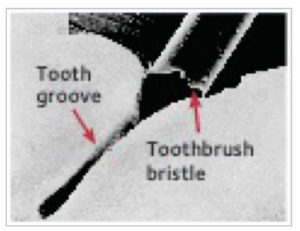
Tooth decay often occurs on the chewing surfaces of back teeth. The good news is that sealants can help protect these surfaces from tooth decay and improve your chances to stay filling-free.
What causes tooth decay? Your teeth are coated with a sticky film of bacteria called plaque (pronounced PLACK). The bacteria convert the sugars you eat and drink into acids that attack the strong, outer layer of your tooth, called enamel. Over time, this can weaken the enamel and cause cavities.

Even a toothbrush bristle is too big to reach inside a groove in the tooth (magnified).
What is a sealant? A sealant is a material applied to the chewing surfaces of your back teeth, which have deep pits and grooves. The material flows into these pits and grooves and then hardens. Once your teeth are sealed, food and plaque cannot get in. The sealant forms a barrier against acid attacks.
How are sealants applied? Your teeth are cleaned and the chewing surfaces are prepared to help the sealant stick to your teeth. The sealant is painted onto the chewing surface where it bonds to your tooth and hardens. Sometimes a special light is used to help the sealant harden. It usually takes only a few minutes to seal each tooth.
How long do sealants last? Sealants may last several years and can be reapplied if needed. As long as the sealant stays undamaged, the tooth surface will be protected from decay (cavities). During your regular dental visits, your dentist will check the sealants and reapply them if needed.
How else can I protect teeth from decay? Sealants protect only the chewing surfaces of teeth. Good care of your teeth at home along with regular exams and cleanings at your dentist’s office are just as important. These good habits reduce your chance of cavities in all of your teeth. Be sure to:
- Brush your teeth twice a day with a fluoride toothpaste.
- Clean between your teeth daily.
- Eat a healthy diet that limits sugary beverages and snacks.
- See your dentist regularly for prevention and treatment of oral disease.
